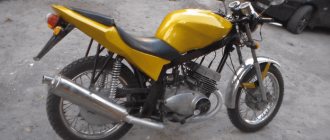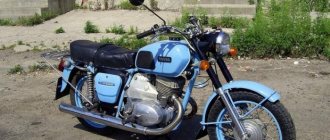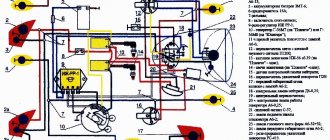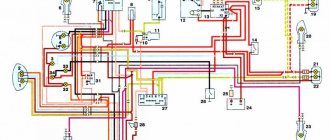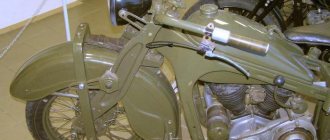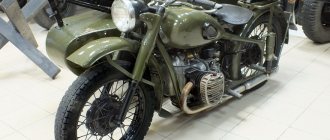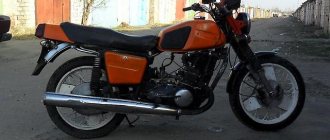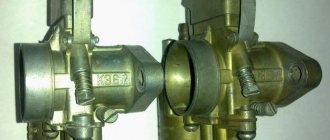Many Soviet motorcycles had an outdated design, but not the Izh Planet Sport. Modern and technologically advanced by the standards of those years, it was produced a good half century ago, and it was highly valued not only in the Soviet Union, but also in other countries where this model was exported. Even after production ceased, Izh Sport was raced by motorcyclists who knew full well that this bike was head and shoulders above most of its contemporaries. And this despite the fact that it cost about a thousand rubles - a huge amount at that time , considering that some engineer received about 100-120 rubles a month.
Design
Developed in 1974, the bike had an original appearance, and was very reminiscent of Japanese motorcycles of that era. A single-level seat, a massive headlight with an integrated speedometer, an elongated gas tank with plastic linings to protect the paintwork from contact with the knees, an impressive chrome exhaust – a classic! But in the case of Izh Planet Sport, technical characteristics were still the main reason for the popularity of the model. Stylish design is good, but design will not take you across the vast expanses of the USSR without any problems.
Izh Cross
Greetings to all connoisseurs of motocross motorcycles! The “All About Moto” website, and in particular its sections related to motorcycle mechanics, will enlighten you about the tuning that creates enduro bikes.
Today we will talk about Izh Cross. After reading this article, you will finally understand what this “nickname” of the iron horse is associated with.
I would like to point out right off the bat that there are no serial bikes with such an official name and never have existed. For some motorcycle enthusiasts, this term serves as another name for the legendary Izh Planet Sport. Others carry out sports tuning of a bike from the Izhevsk Motor Plant, which is later called Izh Pod Cross or Izh Planet Cross. Let us also note that Jupiters are also amenable to such modernization in domestic practice. All types of light and medium bikes are suitable for amateur cross-country reformation. And since the above-mentioned Russian motorcycles are among the most powerful in these classes, they are often taken as a base for further modernization and tuning.
Izh Cross, which can be bought today in many cities and villages (since there are many mechanical enthusiasts in our homeland). In this case, you will not have to study a sea of information regarding the features of the structural alteration of the iron horse. However, such a decision will slightly deplete your family budget.
Specifications
Most of the Izh Sport components were produced in the USSR, although some parts were imported: Japanese Mikuni carburetor , Hungarian optics from Pannonia , Italian Veglia Borletti speedometer and some other little things. The technical characteristics of the Izh Planet Sport 350 were excellent; the thrust-to-weight ratio of the motorcycle was almost twice that of the super-popular Jawa 350, providing acceleration from 0 to 100 km/h in 11 seconds! The motorcycle was so reliable that there were rumors among Soviet bikers that it was originally developed exclusively as an export model. The service life of the CPG, according to reviews, reached 50-60 thousand kilometers, which is a record for a 2-stroke engine. The maximum speed of the Izh Planet Sport is 140 km/h .
Engine
On the Izh Sport in the first years of production, the power reached 32 horsepower , but later it was reduced to 28 hp. for the sake of efficiency and engine life (volume - 340 cm³). The separate lubrication system and engine mounting on rubber mounts implemented in this model were original innovations, thanks to which the bike successfully competed with Japanese and European models in the markets of Great Britain, Finland and other countries. Excellent engine performance combined with high build quality made this bike incredibly popular.
Transmission
The bike is equipped with a classic 4-speed gearbox , simple and reliable. Gears change in the usual manner, 1-N-2-3-4. The gear ratio of the top, fourth gear is 1.0, and you can safely switch to it already at 70 km/h - it will ensure smooth acceleration.
Chassis and brakes
Despite some innovative solutions, the Izh Planet Sport characteristics corresponded to its time. That’s why the motorcycle got a regular, welded frame , and the fork is a simple rodless telescope with a free play of 150 mm. At the rear there is a swingarm with a stroke of 95 mm, so the suspension cannot be called soft. The brakes are drum brakes , not very effective, and the declared stopping distance at a speed of 60 km/h is at least 16 meters .
Electronics
The electronic content of this model was partially imported. Thus, the sound signal was produced at the Japanese company Nikko , the ignition switch was borrowed from Jawa, original Magneti Marelli spark plugs came to the Soviet Union from sunny Italy, and no less original batteries came from the Land of the Rising Sun. But in general, the electrical circuit of the motorcycle is simple and easy to understand.
Weight and dimensions
The dry weight of Izh PS is only 135 kg . Thanks to this, the bike has good dynamics and does not forbid some recklessness, which, in fact, is why Soviet motorcyclists fell in love with it. Its dimensions are appropriate; this model is more compact than Izh Jupiter 5 or Planet 3.
Controllability
For bikers accustomed to modern motorcycles, riding an Izh PS may seem unusual. The bike handles well, but the steering angles are wide and you can easily drop the bike, especially when turning at low speed. This feature is worth keeping in mind.
Fuel consumption
Although the declared fuel consumption does not exceed 3.5 liters at a speed of 50 km/h, during control measurements in normal mode it is about 6 liters . When driving off-road, it can be even higher, but the 14-liter gas tank is enough even for long trips. The Izh Planet Sport engine prefers gasoline with an octane rating of at least 93, but in fact you can safely fill in AI-92 purchased at a trusted gas station.
Mass production
Mass production has been carried out at the Izhevsk Machine-Building Plant (currently OJSC Izhmash and DOJSC Izhmash-Moto) from 1946 to the present day, during which about 11 million motorcycles of various models have been produced. This information is not entirely reliable, since the plant went bankrupt in 2008.
In 1946, the plant received equipment, drawings and technologies exported from Germany as part of reparations, and began production of the Izh-350 motorcycle - making a copy of the German DKW NZ-350. It was a mixture of varieties of the German motorcycle. So, the crankcase was made of aluminum alloy, like the early models, but the mud flaps were like the later ones, produced already during the war. The motorcycle was adapted for domestic electrical equipment and instruments. In general, the general appearance and design were almost identical to the German original. It should be noted that for its time it was a fairly modern, simple and reliable motorcycle. It was decided to put the production of the motorcycle at the weapons factory.
A characteristic feature of the Soviet motorcycle industry in the 40-60s was the production of sports modifications of road motorcycles. Having laid the foundation for the development of mass motorsports, they at the same time became “test benches” for testing those solutions that were then applied to serial products. In 1948, the Izh-350S motorcycle was manufactured in Izhevsk with a telescopic front fork, replacing the archaic parallelogram one. The rear wheel received a spark plug suspension with spring-hydraulic shock absorbers. The engine had an aluminum cylinder with a cast iron liner. Its power increased to 14 hp. In 1950, mass production of an improved version of the Izh-50 sports motorcycle began.
In 1951, in a short time, designers created a more advanced model, the Izh-49. Due to the use of a telescopic front fork, a rear suspension with hydraulic shock absorbers and other improvements, ride comfort and operational reliability have increased, and the motorcycle's cross-country ability in poor road conditions has improved. Without stopping production, a transition was made to the mass production of Izh-49 motorcycles, which gained universal popularity among the population of our country and opened the way to foreign markets. This was the first model of Izhevsk motorcycles with a side trailer, the production of which was organized in Vyatskie Polyany. Subsequently, a pilot batch of cars with sidecars was produced.
In 1955, production began of a new family of sports motorcycles with a welded tubular frame and swing-arm rear suspension. The Izh-54 for road racing had an 18 hp engine, and the Izh-55 for cross-country and multi-day competitions had a 16 hp engine.
The design group working on the design of motorcycles was allocated to a special bureau. In 1956, a new model appeared - “Izh-56”, and soon the plant already produced a pilot batch of them. The design of the motorcycle was significantly different from those previously produced. The stamped frame became tubular, deep wheel guards were provided to protect the driver from dust and dirt, and a sponge rubber saddle with a cover was provided. The carburetor and air cleaner were covered with covers, which, in combination with the tool boxes, gave the car a good appearance. Wheels with straight spokes became interchangeable. It was 20 percent more powerful than its predecessor, with engine power increasing to 13 hp. It is not surprising that the Izh-56 has become a more popular model. Its “circulation” during production amounted to 680 thousand units, of which 130 thousand were equipped with a side trailer. Overall the car has become more modern.
Subsequently, in collaboration with employees of the central design experimental bureau, a number of prototypes of motorcycles and individual components are created and tested. The advanced design group designs the Saturn, Orion, and Sirius motorcycles. The most original of them was the Saturn - a 250 cm³ class car. Unlike a regular motorcycle with a welded frame, this was a frameless model. The gas tank, steering column and tool boxes were a single unit, in the lower part of which the engine was suspended. At the same time, several modifications of sports cars were created. On the basis of the first road motorcycles "Izh-350" and "Izh-49" sports cars "Izh-350S", "Izh-50", "Izh-50A", "Izh-50B" appeared, on which our athletes begin to take part in motorcycle competitions and successfully defend the honor of the Izh brand.
In 1954-1955, the Izh-54 and Izh-54A motorcycle models were developed for road racing. Their engines developed power up to 20 hp. Competing on these machines, our athletes, including Master of Sports V. Medvedev, won the title of USSR champion and took prizes. Around the same period, the Izh-55M and Izh-55K motorcycles were created for multi-day and cross-country competitions. In the future, they are replaced by more reliable models “Izh-57M” and “Izh-57K”.
In the second half of 1958, the designers of the bureau faced a new task - preparing for the release of the Izh Jupiter motorcycle. Izhevsk machine builders demonstrated a prototype of the new model at the World Exhibition in Brussels already in 1957. The motorcycle was first called “IZH-58”, and then renamed “Izh Jupiter”. The motorcycle retained the crew part of the Izh-56, but had a completely new two-cylinder engine. The first prototypes showed very good results. The engine power was increased to 18-19 hp, the engine had an original design of separate cylinders. The gearbox was also more convenient to use. Improved bearing lubrication. Engine production was organized at the Izhevsk Mechanical Plant. Serial production began in 1961. The motorcycle was produced in two modifications - both for riding alone and with a side trailer.
Since 1962, on the basis of the Izh-56 machine, the production of the Izh Planet motorcycle was mastered. The crew of this model was maximally unified with the Izh-Jupiter. The warranty mileage of the Izh-Planet compared to the Izh-56 has increased by 2000 km, and the service life of the cylinder and piston group parts has been increased by one and a half times thanks to the use of a contact-oil air cleaner.
The period 1966-1970 for motorcycle manufacturers was marked by the development of new road motorcycles “Izh Planeta-2” and “Izh Jupiter-2”.
The years 1971-75 were devoted to the production of road motorcycles “Izh Planeta-3”, “Izh Jupiter-3”, “Izh-Jupiter-3K”, “Izh Planet Sport”. The listed brands of motorcycles combine reliability in operation and ease of maintenance. With the acquisition of experience in developing structures, equipping production with new progressive equipment, and the emergence of new materials, the development period of new models has shortened, the volume of their production has increased, and performance characteristics have improved. An example is Izh Jupiter-3, whose power has increased by almost 40 percent compared to its predecessor. The Izh Planeta-3 and Izh Jupiter-3 models were awarded the State Quality Mark. Their production was increased in 1975 to 250 thousand per year.
The Izh Planet Sport motorcycle, developed in 1973, stands apart. This is a completely new model, which was different from the German one. In the first years, the motorcycle had imported components. The engine, combined with a Japanese Mikuni carburetor, developed a power of 32 hp, and a new separate lubrication system was used here for the first time. This model was very popular among young people. Subsequently, the plant abandoned imports and began to replace components with domestic ones, which led to a change in the appearance of the motorcycle for the worse; the engine began to develop only 28 hp, and reliability dropped. The IZH-PS 01 model was being prepared for production with the unification of some components with road models, but it was decided to completely discontinue this legendary model
In the early 80s, construction of a new motorcycle production complex was completed. Highly automated, equipped with overhead assembly conveyors, it was designed to produce 450 thousand motorcycles per year. In 1981, production of Izh Jupiter-4 motorcycles began in the new complex. And in 1982, Izh Planeta-4 appeared with new 12-volt electrical equipment.
Since 1985, production of the Izh Jupiter-5 motorcycle began with an engine whose power was reduced from 28 to 24 hp. An “emergency start” button appeared, which turned off all devices except the ignition when starting with a low battery. Izh Planeta-5, released in 1987, received a significantly updated engine with a power of 22 hp. and a new appearance: gas tank, trim and instrument panel. Soon “Jupiter” changed in a similar way. During the same period, based on the Japanese XT-550 engine, prototypes of the Orion, Marathon and Sprinter motorcycles, which are still promising to this day, were designed and manufactured. In terms of their design and characteristics, these were very modern and bold models.
Over the entire period of Izhi production, the color range was not large, so the frame was painted in a classic black color; the rest was dominated by blue, red, and light brown.
In the period 1992-96, the Izh 9.204 cargo side trailer and the Izh 9.604 GR cargo module were developed. The design of the cargo module was developed in such a way that it can be installed on any motorcycle of the Planet or Jupiter families. By installing a cargo module instead of the rear wheel and pendulum fork of a motorcycle, you get a three-wheeled cargo motorcycle with a symmetrical arrangement of wheels. The presence of a transfer case, differential lock, and reverse gear expands the scope of use of the motorcycle.
From 1995 to 1998, a range of stationary engines was developed: SD 101 - based on the Izh-PS engines and SD 1012 - based on the Izh-P-5 engine. Simultaneously with the development of the Izh NTS centrifugal self-priming pump, the Izh MP-1 motor pump with an SD 1012 engine was designed.
1997 was marked by the development of the Izh 6.92001 motorcycle for transporting fire-fighting equipment (motor pump, set of fire hoses, fire extinguisher, etc.) and the Izh 6.920GR cargo motorcycle with the Izh-Yu-5 Sb.1-08.10 liquid engine cooling, developed at the Izhevsk Mechanical Plant in 1990-92.
In the period 1996-2000, a fundamentally new model appeared - the Izh 6.113-05 motorcycle (aka "Junker") in the chopper style.
The Moscow traffic police platoon, in order to support the domestic manufacturer, used Izh-Junker models as an experiment for several years. For various reasons, in the future, the management of the Moscow traffic police refused to continue purchasing Izh motorcycles.
Due to large debts, the IZhmoto plant was mothballed in 2008 for an indefinite period, and most of the equipment was sold off.
Repair and tuning
Thanks to its simple design, all service operations with Planet Sport can be done independently. But some original units are now almost impossible to find, and those rare specimens that can be bought second-hand are often very expensive. But this is the only option - who will buy a rare motorcycle and install Chinese spare parts on it?
Repair
Repairing Planet Sport is not difficult. If you've already seen at least one Soviet bike, then you've seen them all. Despite some differences from its peers in the model range, understanding the design is not difficult. The Izh Planet Sport motorcycle has technical and other characteristics that correspond to the spirit of its time, and there is nothing overly complicated about it.
Spare parts
Spare parts for Planet Sport are difficult to obtain. The IzhMash plant stopped producing them decades ago, and some components were imported from other countries, so now it makes sense to look for them on sites like Avito or on the forums of Izh motorcycle owners. But get ready to shell out some money - rare original units are usually expensive, and you still have to look for them anyway. In some cases, it is possible to replace it with a non-original one, but rarely. In Planet Sport, almost everything was developed from scratch in the USSR, so there are simply no analogues, although some spare parts are suitable from Japanese motorcycles of that era.
Tuning
In Soviet times, it was relatively popular to increase the working volume of an engine cylinder by boring it, and the donor of the piston group was usually the Czechoslovakian CZ 514. They resorted to such an operation infrequently - the Izh Planet Sport 350 technical characteristics are already quite good, and such tuning sharply reduced the engine's life. Nowadays there is no point in tuning at all, since motorcycles restored to their original condition are valued, and not copies tortured by “collective farm tuning”.
Motorcycle modifications
There was only one main factory modification of the Izh Sport, on the basis of which several specific subtypes of the motorcycle were made - for cross-country races, for long trips over rough terrain and for ice racing. The first is popularly called Izh PS Cross, although the correct name is Izh K-15. The enduro version is called Izh M-15. Both are now very difficult to find for sale in decent condition.
But the existence of the Izh Planet Sport 500cc is just a widespread myth. People often tell stories that the IzhMash plant produced a 500 cc limited version, but this is not true. Garage craftsmen sometimes bored the engine to increase volume by installing pistons from CZ, but even in this case the volume did not reach 500 cm³, since the cylinder walls were too thin to allow such boring. The existence of the “reborn” Izh Planet Sport 2 with a 650 cm³ Rotax engine from BMW also belongs to the realm of myths. This “duck” with fake photos at one time alarmed the Internet, but, as it turned out, it was just someone’s joke.
BICYCLES YOU'VE NEVER SEEN: IZH K-16 350 CROSS MADE IN RUSSIAN MANUFACTURE
This is a very late K-1986 '16.
Izh (Izhstalzavod) is a Russian motorcycle brand founded in the city of Izhevsk in 1929. This was not the first attempt to build a Russian-made motorcycle. These would be the “Duks” of 1914-1918, built in Moscow and Riga, but the “Duks” were not very good, so in 1929 a commission of Soviet experts of the “Presidium of the Supreme Council of the National Economy of the USSR” decided: to re-equip the Izhmash arsenal to a large motorcycle factory.
Note that the kickstarter and shifter have the same shaft design - ala CZ.
Izhevsk was considered the most suitable location for a motorcycle factory, since the city had a full range of industrial production, from steel smelting to the production of complex machine tools, plus the workers had the necessary qualifications and there were no difficulties in production. supply of raw materials. On the basis of the Kalashnikov assault rifle plant, located on Bazarnaya Street in Izhevsk, the construction of an Experimental Motorcycle Plant has been approved.
Let's skip the next 55 years of utilitarian Izh street bikes to get the Cross Izh K-16. In production in various versions from 1973 to 1986, the Izh K-16 Cross was equipped with a two-stroke air-cooled IZH-PS engine with a capacity of 350 cc. Equipped with a 36 mm Jikov carburetor, it produced a claimed 36 horsepower. The Motoplat ignition system provides a stable spark at high speeds.
The engine could operate with 32 mm and 36 mm carburetors, which explains the strange multi-section air intake.
The frame is similar in design to the CZ 380, because it was the only SUV available in Russia at that time that could be copied. The front fork offered 8 inches of travel, but it was not uncommon for Russian forks to be replaced with CZ forks. The rear suspension used DeCarbon gas-hydraulic shock absorbers with remote reservoirs.
There are Izh K-16 collectors, but the bikes are very rare outside of Russia.
The overall design was simple, and it weighed 250 pounds (thanks to a lot of steel parts and very little aluminum). Unfortunately, the Izh K-16 Cross was not popular in Russia, where riders preferred CZ and hard-to-find Japanese brands. Although there were plans to export K-16s to European countries and possibly the United States, few of them made it across the ocean to be seen in any numbers. In 1986, the plant was closed and the K-16 was forgotten.
Advantages and disadvantages
The advantages and disadvantages of innovative technology are always clear. The PS model, which has always been expensive and expensive to maintain, did not escape this fate.
Advantages
- Excellent acceleration dynamics .
- Solid range , up to 300-350 km with quiet driving on the highway.
- resource for a 2-stroke engine .
- Excellent reliability is a rare quality for Soviet motorcycles.
Flaws
- Weak drum brakes .
- The difficulty of finding spare parts and consumables in our time, as well as their high cost.
- It is difficult to find a copy in good condition and without “collective farm” tuning.
Owner reviews
As a child, I rode a PS around the village, and then I didn’t even know what it was. The boys were jealous, they all had Minskis and Voskhods)) Only later did I understand what kind of device it was, but it was too late, my dad sold it to someone for next to nothing... It’s a pity, the warmest memories remain. Dmitry, Bratsk.
I owned a collectible copy, I restored it from junk myself in the late 90s, I put in a lot of work, it took about three years by the time. I sold it because I desperately needed the money, although my heart was bleeding. Maybe it was for the best, even then you had to search for spare parts in the daylight, but now, apparently, you won’t find anything at all. Anatoly, Krasnodar.
In the 80s, he took part in amateur competitions, then, when everything went downhill, he rode himself, the spendthrift was PS Cross, he walked along the old DOSAAF track like a tank! It is from him that I have a love for enduro cross-country bikes, I have been riding for 40 years, and I myself work as a coach in a children’s motorcycle club. A motorcycle for the ages, the Izh Planet Sport 350 had technical characteristics that no Javanese with Chesets could ever dream of. Anton, Minsk.
FAQ
- How many cubes does he actually have? 350? No, 340. Anything more is either a consequence of cylinder boring or just a lie.
- Are spare parts from other Izhaks suitable for it? With rare exceptions, no. You can find more details on the specialized forums of owners of motorcycles from the IzhMash plant.
- Does it make sense to buy a destroyed copy and restore it to the original? If you have time and money, why not? But the task is not easy.
Conclusion
In the modern world, restoration of retro motorcycles remains the preserve of enthusiasts who are willing to spend not only a lot of time, but also a lot of money on their favorite hobby. If you are one of them, then Izh PS can take its place in your garage. But there is no point in buying it specifically for driving, unless you are a fan of retro technology.
Specifications
| Maximum engine power: | 32 l. With. at 6700 rpm min HP |
| Working volume: | 340 cm3 |
| Motor type (cylinder arrangement, number of strokes): | single-cylinder, two-stroke, with three channels and five purge windows |
| Number of cylinders: | 1 |
| Number of valves: | |
| Intake type (Injector / Carburetor): | |
| Bore and stroke: | |
| Starting system (Electric starter, kick starter): | |
| Maximum speed in km/h: | 140 km/h |
| Cooling system: | Air |
| Transmission (gearbox): | Mechanical 4-speed |
| Clutch (Dry / Wet): | |
| Drive unit: | Chain |
| Frame: | Steel |
| Chassis | |
| Suspension (front/rear travel): | |
| Brakes (Front/Rear): | |
| Wheels / Tires / Rubber: | |
| Dimensions and weight | |
| Dimensions (Length / Width): | |
| Seat height: | |
| Ground clearance: | |
| Curb weight: | |
| Wheelbase: | 1390 mm |
| Weight: | 135 kg |
| Fuel tank capacity: | 14 l. |
| Battery capacity: | |
| Year of release: | |
| Country of Origin: |
Technical characteristics of Izh Planet Sport
For 1974 the motorcycle looked very modern. Painted in a bright orange color, which became a signature color for cars of this family, it stood out in the traffic and was the envy of many Soviet citizens who had a category “A” driver’s license. But it was not only about the beautiful style. The technical characteristics declared for Izh Planet Sport matched the design. In 1974 they looked like this:
- Dimensions (length/width/height) mm – 2070/790/1150.
- Wheelbase – 1390 mm.
- Operating ground clearance – 135 mm.
- Weight (dry) – 135 kg.
- The engine is a single-cylinder, two-stroke, with three channels and five purge windows.
- Engine displacement – 340 cubic meters. cm.
- Cylinder diameter and piston stroke – 76×75 mm.
- Rated power – 32 l. With. at 6700 rpm min and compression ratio 10.5:1.
- Lubrication supply is separate.
- Cooling is air.
- The combustible mixture formation system is carburetor, with an inlet channel diameter of 32 mm.
- On-board network - 12 V.
- Brakes are drum brakes, with a front drum diameter of 190 mm and a rear drum diameter of 170 mm.
- The gearbox is four-speed, with foot shift. There is a reverse gear.
- The maximum declared speed is 140 km/h.
Speaking about the history of the creation of the bike, it should be noted that the chief designer of the project, Vasily Ivanovich Panov, when developing the new Izh Sport 350, used technical solutions that had proven themselves on sports motorcycles created together with MAMI specialists:
- The engine has a separate lubrication system, thanks to which the power unit components withstood high loads, and fuel consumption in economical mode was reduced to 4.5 liters per 100 km.
- Closed frame made of tubular profile, heat treated after welding.
- Shock-absorbing rubber pads on which the power unit was attached to the frame. This reduced vibrations and increased operating comfort.
- Modern design pendant. The front wheel has a telescopic fork. The rear wheel suspension is pendulum type.
The technical characteristics obtained on the Izh Planet Sport 350 were achieved, not least, thanks to the careful fitting of parts. Due to the lack of necessary technology, this adjustment sometimes had to be done manually.
